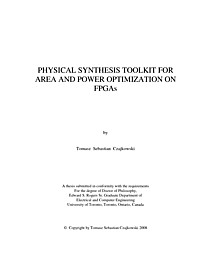
Physical Synthesis Toolkit for Area and Power Optimization on FPGAs
A Field-Programmable Gate Array (FPGA) is a configurable platform for implementing a variety of logic circuits. It implements a circuit by the means of logic elements, usually Lookup Tables, connected by a programmable routing network. To utilize an FPGA effectively Computer Aided Design (CAD) tools have been developed. These tools implement circuits by using a traditional CAD flow, where the circuit is analyzed, synthesized, technology mapped, and finally placed and routed on the FPGA fabric. This flow, while generally effective, can produce sub-optimal results because once a stage of the flow is completed it is not revisited. This problem is addressed by an enhanced flow known Physical Synthesis, which consists of a set of iterations of the traditional flow with one key difference: the result of each iteration directly affects the result of the following iteration. An optimization can therefore be evaluated and then adjusted as needed in the following iterations, resulting in an overall better implementation. This CAD flow is challenging to work with because for a given FPGA researchers require access to each stage of the flow in an iterative fashion. This is particularly challenging when targeting modern commercial FPGAs, which are far more complex than a simple Lookup Table and Flip-Flop model generally used by the academic community. This dissertation describes a unified framework, called the Physical Synthesis Toolkit (PST), for research and development of optimizations for modern FPGA devices. PST provides access to modern FPGA devices and CAD tool flow to facilitate research. At the same time the amount of effort required to adapt the framework to a new FPGA device is kept to a minimum. To demonstrate that PST is an effective research platform, this dissertation describes optimization and modeling techniques that were implemented inside of it. The optimizations include: an area reduction technique for XOR-based logic circuits implemented on a 4-LUT based FPGA (25.3% area reduction), and a dynamic power reduction technique that reduces glitches in a circuit implemented on an Altera Stratix II FPGA (7% dynamic power reduction). The modeling technique is a novel toggle rate estimation approach based on the XOR-based decomposition, which reduces the estimate error by 37% as compared to the latest release of the Altera Quartus II CAD tool.



















